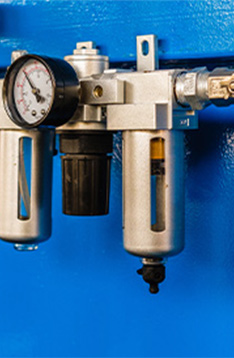When To Replace Pneumatic Filters
Post By: Ryan King On: 08-03-2021 Read Time: 4 minutes - Guides - Pneumatics
Post By: Ryan King On: 08-03-2021 Read Time: 4 minutes - Guides - Pneumatics
As we know to our cost, air is not pure, and can pick up even more contaminants as it travels through a pneumatic system. A filtration unit of some kind is therefore essential to keep your pneumatic machinery in tip-top condition. Plus, a properly maintained filtration unit will make the whole system safer, more efficient and more cost-effective to operate.

You should make sure that the filters are checked and replaced regularly to keep down contamination levels. This means at least once a year, and immediately in the event of any leaking or odour. Always follow manufacturers' recommendations so that guarantees remain valid.
The air in your pneumatic system can pick up contaminants from four main sources:
These contaminants fall into ten common types, found in water, oil, air and dirt. Water accounts for almost all liquid contamination, whether that’s from cooled condensed water, aerosol or water vapour. Oil can contain unburned particles of hydrocarbon, which affect the system in liquid, vapour or aerosol form. Dirt comprises rust, pipe scale, micro-organisms and atmospheric dirt.
Efficient filtration will get rid of nine of these, with the exception of micro-organisms. Unless specialist filtration is used, some micro-organisms will remain even after normal air and water filtration. So, in industries such as Food and Beverages or Pharmaceuticals, a higher calibre of filtration is required.
For most applications, coalescing filters will substantially reduce the six water and air contaminants, and these are typically supported by other filters to remove those from oil and dirt. All filters are designed for the periodic replacement of cartridges or other filtration elements, so that quality compressed air is always available. Regular changing of filters will keep your energy costs down, because clogged filters require more power to maintain effective function.
Compressed air filters are a critical component of your pneumatic system, and must often function in extreme or arduous environments. They suffer constant variations in pressure, temperature and humidity, as well as the potential for chemical contamination or the stresses of a pulsed air supply.
All these variables can cause weakening and degradation of the filter elements, with long periods of constant bombardment by high-velocity particulates leading eventually to failure. Even a microscopic hole or minor damage can be disastrous, as air under pressure finds the line of least resistance to force its way out. The whole element will then rupture, with all the air contaminants leaking into the downstream supply. Sudden and significant changes in pressure (pressure spikes) can also cause instant tearing, so if you're (re)pressurising your pneumatic system you should always open isolation valves slowly to prevent any damage.
The air quality in pneumatic systems is governed by ISO standards to specified degrees of purity. These standards are observed by filter manufacturers when specifying recommended maintenance periods. You should follow these recommendations to ensure that your machinery will deliver optimum performance. You may also have to change a filter element if it gets blocked, altering the differential pressure and causing a reduction in downstream pressure. Although this is not the main reason for changing your filter, higher differential pressure will increase your power consumption, and replacing the filter might solve the problem.
Regular maintenance and replacement parts are an insignificant outlay compared to the potential for downtime and ruined product when a filter fails. Regularly changed filters offer full protection for personnel, equipment and processes, and guarantee that your compressed air is of premium quality. They also reduce operating costs, while increasing operational security, productivity and profitability.
The short answer is no. Neither solvent nor soap and water will wash the contaminants out of your filter elements, and you could cause them significant damage.
The only part of the filter that you can see is the drainage layer, which is there to prevent the downstream passage of coalesced liquids. You won't see the actual filtration media unless you dismantle the filter, because it's underneath the drainage layer. Not only that, but many contaminants are simply invisible to the naked eye, particularly the minute sub-micron particles and aerosols that are treated in coalescing and dry particulate filters.
The answer to this is the same – all you can see on the outside of the filter is the drainage layer, with all the essential filtration elements hidden inside its support cylinders. While the drainage layer may not look damaged, the filter media may still be damaged underneath, again allowing for downstream air flow contamination.
Yes. Like any other part of a filtration unit, the float drain is subject to wear and tear and should be replaced annually in order to provide the best quality airflow. Some people are opting for more energy-efficient electronic drains (also called zero loss drains.) However, these cost a lot more to service and don't add significantly to the benefits you achieve by regular replacement of the float drain.
This type of filter functions differently to a dry particulate or coalescing filter, although they often use the same housing and can appear identical on the outside. Adsorption filters attract gaseous oil vapours from compressed air, via a layer or bed of activated carbon, which then form a film on that layer. The smaller, in-line units are subject to many variables, and the adsorption capacity of activated carbon for oil vapour is limited. Therefore, the adsorption beds or filter cartridges have to be replaced when they've reached this capacity.